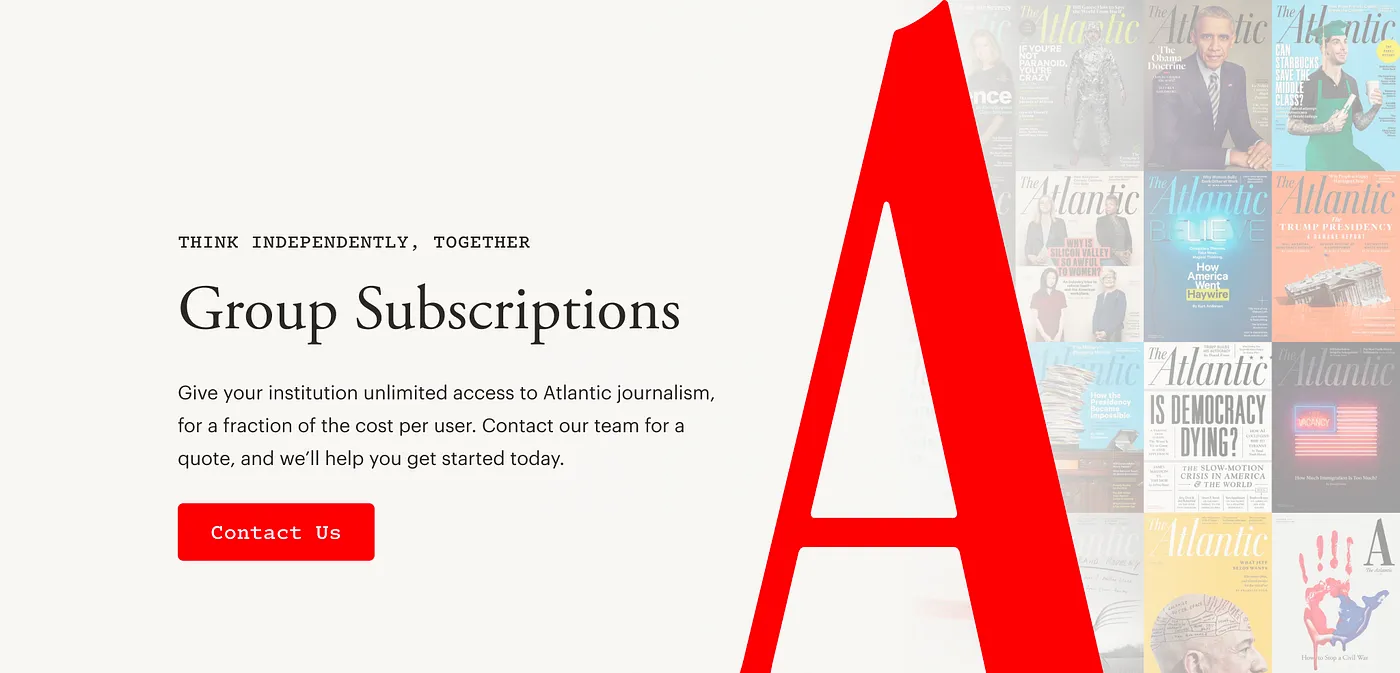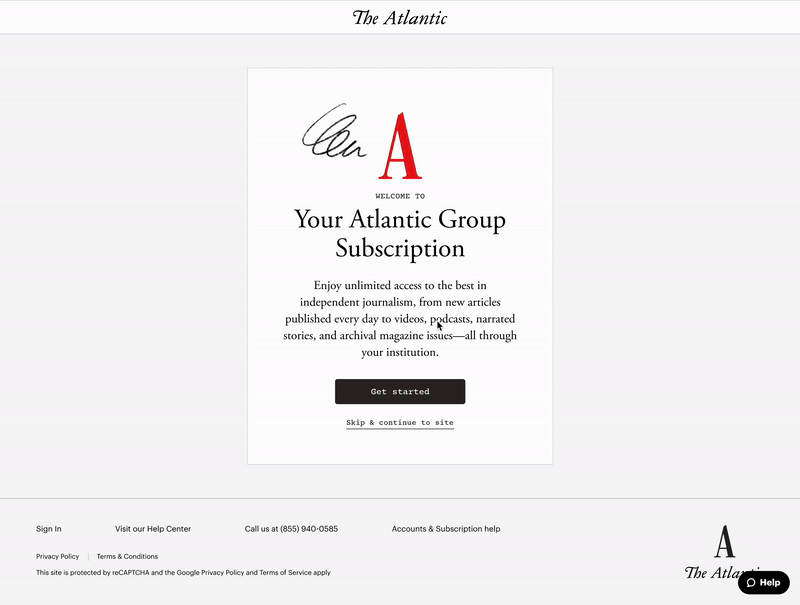How we introduced group subscriptions to The Atlantic

From the early days of market research homing in on a target audience to finding ways to incorporate user feedback throughout the development cycle, the goal was “seamless.”
For years, The Atlantic has talked about developing a specific product for institutions. Our peers in the media industry have publicly reported successful metrics that show, to various degrees, how group subscriptions play a role in their revenue growth. Additionally, our teams would often hear requests for this type of access.
We had our individual subscriptions but, until recently, there was no way for someone to buy access to The Atlantic and distribute it across an organization.
Sizing the opportunity
It all started with a scoping exercise, trying to forecast the total addressable audience. Our teams conducted extensive market research to assess where there was truly a fit and what The Atlantic's unique offering would be.
We looked into academic institutions, corporations, and nonprofits. Each sector had its own needs and requirements.
“We are excited about the range of institution types that we'll soon be able to support. To start, we decided to focus on education, given the strong demand and impact potential.” said SVP of Business Development & Strategic Partnerships Mary Liz McCurdy.
In our research, it was very clear early on that the academic market had the need to access our publication. The Atlantic's modern-day and rich historical journalism is used in syllabi, read and shared by students and teachers, and cited in college papers and theses. However, there was no way for teachers or librarians to grant school-wide access to their students or teachers.
It seemed like a no-brainer. “It became very clear that it made the most sense to dive into the education sector: educators, professors, librarians, students,” said Deirdre Torrance, VP of Partnerships & Business Development. This way, from a strategic standpoint, we could also reach younger generations of readers where they are: in high school and college.
We needed, then, to understand how students and educators used resources at their schools, how institutions buy resources, and put together what made the most sense for our minimum viable product (MVP).
The Atlantic team are speaking at The Audiencers' Festival in New York on March 15th! Find the full agenda and reserve your spot here.
Giving access to The Atlantic at scale
Our team considered many options for the best way to offer group access to our website. We considered an IP-based approach, for example, meaning anyone using their institution's network would be able to enjoy the subscriber experience on the site. Unfortunately, this approach had limitations. If a teacher or student chose to work or study off campus, they wouldn't have access.
Group access can also be seat-based, giving each person their own unique username and password. Unfortunately for librarians, who are usually managing resources for academic communities, this approach is hard to maintain.
A third option we considered is single sign-on (SSO). With this approach, academic users wouldn't need to create a unique username and password to enter the site; instead, they would be able to have access to an Atlantic account using their own institution's sign-on system.
As Executive Director of Product Mariah Craddick said, The Atlantic “viewed SSO as the clearest way to reach the first milestone — providing a seamless sign-on. That was the number one tablestake.”
This option was beneficial for establishing a relationship with the members of each academic institution. If they have their own Atlantic account, they can sign up for a newsletter. They can manage their own settings. All these options empower users and add value to a subscription. With IP-based access, those actions simply can't be taken.
A seamless user journey
For a product that will reach thousands of people, it's crucial to create an experience that is easy to access and navigate. For our team, this meant changing the design and user flows of certain parts of the website to cater to our new academic audience. One of the greatest challenges we faced was balancing how to incorporate new academic group subscribers into the sign-on experience without confusing our existing individual subscribers.
To make sign-on seamless, we would need to simplify the experience through visual design and content hierarchy. On the sign-on page, we opted for a minimal call to action for group subscribers while maintaining the look and feel that existing readers recognize. Group subscribers arrive on a special landing page where they are prompted to sign in through their institution.
We discovered that our SSO approach came with a caveat: during the sign-on process, we do not retain any personal data of group subscribers, such as names or email addresses. While this met the needs of many academic institutions when it came to data privacy, it presented a potential barrier to personalizing and improving the Atlantic experience for teachers and students.
We solved this issue in the design of an onsite onboarding experience, which introduces these subscribers to The Atlantic's offerings and newsletters. During onboarding, we also prompt users to enter their name, email, and a few additional details.

It made sense to give teachers and students the flexibility to choose where they want newsletters delivered. Collecting this information during onboarding also gives us a better understanding of the needs and preferences of this audience.
> You'll also enjoy: Audience research at The Atlantic, the questions that data can't answer
Looking beyond the classroom
After months of rigorous research, including user testing with actual high school and university staff and students, and fastidious development, we launched group subscriptions in the summer of 2023. So far, over 60 institutions from all over the country have purchased group subscriptions to The Atlantic.
As we introduce this new cohort to The Atlantic, we'll continue to find ways to drive engagement.
“We want to help professors add our journalism to their syllabus and foster more use of The Atlantic in classrooms. Ultimately, we want to look into how we take seniors upon graduation and convert them into individual subscribers,” said Torrance.
Fortunately, while we narrowed our focus to the academic market for the initial product launch, we built group subscriptions to be flexible enough to expand to other sectors in the future. Now, we have a product to reach them, too.
Mariah Craddick, Gina Bulla, Mary Liz McCurdy, and Deirdre Torrance contributed to this post.



